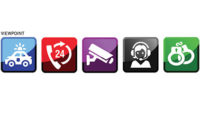Up until now, the security industry has been experiencing an overload of video information that sometimes is only useful in a reactive capacity for investigative and forensic purposes. Now, an opportunity has emerged to empower monitoring centers to leverage analytics and machine learning in a proactive position.
For instance, consider a warehouse where 10 or more cameras were installed several years ago, just passively recording video. Today, installation companies are capable of generating automatic video services by programming those cameras remotely, and monitoring those cameras at the monitoring center with these new services. These devices can be configured to ignore events that are not security-related, only sending alerts that represent likely intrusions, reducing nuisance alarms and increasing security effectiveness. Such smart video services are excellent new RMR generators with affordable costs for the monitoring center.
Artificial intelligence and machine learning have come a long way. Cameras can help discern a person versus an animal, or a certain vehicle, specific clothing, human behavior, the direction someone is walking and much more. Plus, it can do so during set times. With machine learning, the capabilities of the system are rapidly improving beyond those of a human operator. This growing field opens up a variety of automated services that were not possible just a few years ago, and many without needing operator intervention.
AI and deep learning enable video surveillance systems to “learn” what a potential threat may look like. AI will define and recognize typical activity for a particular area, and then detect and flag unusual events. This adds a new level of automation to monitoring and surveillance. Imagine how a greater level of analytics can help an operator determine if a true threat exists by helping to categorize and prioritize threat levels for an accurate response.
The cloud has opened the doors for monitoring centers to easily add these new services; and change is coming faster than you think. From audio to video, everything is moving into cloud services — not just security. It’s simply a natural evolution for this industry. Today, it’s not about how a monitoring center is going to benefit from cloud hosting — it’s about how business will be conducted in the future.
The cloud has made it possible to begin with a minimal investment, set-up time and IT knowledge and still be compliant with UL 827 and other standards. With artificial intelligence and automation, less training is required for operators, especially with video verification and new services tied into the monitoring center automation systems.
Monitoring centers can now offer services beyond just security. For instance, the same camera can combine security services with business management. Services can include video verification, remote guarding, asset management and video tours. Think of the possibilities that emerge when AI is used to identify suspicious human behaviors, object detection, shoplifters, stock room control and more. Customers are now able to pick and choose what services they require now, and add more in the future.
Video verification and video monitoring have their own niche applications. For outdoor intrusion detection, video-based detection coupled with operator verification is far superior to the traditional surveillance set-up, where multiple real-time camera views are used to try and detect an intruder. This model will often result in missed detections due to operator fatigue, as operator attention and concentration quickly fade. For indoor live monitoring of suspicious behavior in retail environments, analytics are still evolving and lack the effectiveness of trained operators in identifying, following and assessing suspicious behavior. With that said, it is only a matter of time until AI and analytics close this gap with human judgement. Video verification and video monitoring are powerful tools for the right application. Add value for your customers by providing services that include video monitoring and its future.
Video verification is inherently reactive as it prompts the review of video in response to an alarm activation. For residential customers, this approach adds significant value to the alarm assessment process and is rapidly gaining acceptance within this market segment. It is fast becoming more common to use an outdoor video-based detection system to provide advance early notification, even before an intrusion alarm is triggered. Outdoor video detection with immediate operator deterrent action prevents break-ins in most instances, often not triggering the indoor intrusion alarm at all. For commercial and VIP customers looking for a more proactive solution, there’s video monitoring.
Companies already providing video monitoring services in commercial applications use a lot of indoor video for verification. In fact, when installing an intrusion system and surveillance system in the same location, it is common to use the video system to provide the operator with additional information. With this set up, the operator’s workflow does not change; they simply use the video information to assist in the verification process, which significantly reduces requests for police response to false alarm scenarios.
For residential applications, video verification must strike a balance between privacy and results. You have to be very careful to get the correct level of information to monitoring center operators — provide the video they need, but only enable them to view the level of video that is required, and enforce all of that by design. Customer trust is critical — unlike in the commercial setting, this is a customer’s private home. The customer must be convinced that their privacy will be respected and they need to understand how the safeguards are incorporated into the system design. Successfully taking into account privacy, effectiveness and the operational demands will enable you to roll out a strong solution.
Simply put, video verification and other interactive video services are bringing additional, valuable information into the monitoring center. This allows your company to provide a level of service that meets and even exceeds customers’ expectations.





